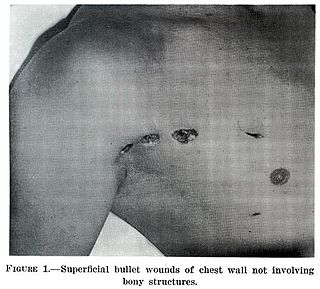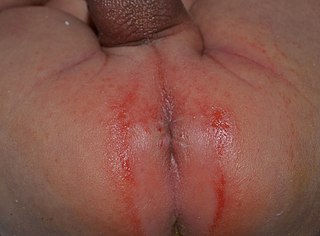
Dermatitis, also known as eczema, is a group of diseases that result in inflammation of the skin. These diseases are characterized by itchiness, red skin and a rash. In cases of short duration, there may be small blisters, while in long-term cases the skin may become thickened. The area of skin involved can vary from small to the entire body.

Skin cancers are cancers that arise from the skin. They are due to the development of abnormal cells that have the ability to invade or spread to other parts of the body. There are three main types of skin cancers: basal-cell skin cancer (BCC), squamous-cell skin cancer (SCC) and melanoma. The first two, along with a number of less common skin cancers, are known as nonmelanoma skin cancer (NMSC). Basal-cell cancer grows slowly and can damage the tissue around it but is unlikely to spread to distant areas or result in death. It often appears as a painless raised area of skin, that may be shiny with small blood vessels running over it or may present as a raised area with an ulcer. Squamous-cell skin cancer is more likely to spread. It usually presents as a hard lump with a scaly top but may also form an ulcer. Melanomas are the most aggressive. Signs include a mole that has changed in size, shape, color, has irregular edges, has more than one color, is itchy or bleeds.

Psoriasis is a long-lasting autoimmune disease characterized by patches of abnormal skin. These skin patches are typically red, dry, itchy, and scaly. On people with darker skin the patches may be purple in color. Psoriasis varies in severity from small, localized patches to complete body coverage. Injury to the skin can trigger psoriatic skin changes at that spot, which is known as the Koebner phenomenon.

A wound is a type of injury which happens relatively quickly in which skin is torn, cut, or punctured, or where blunt force trauma causes a contusion. In pathology, it specifically refers to a sharp injury which damages the Epidermis of the skin.

Tinea cruris is a dermatophyte, a type of fungal infection of the groin region in either sex, though more often seen in males.

Irritant diaper dermatitis is a generic term applied to skin rashes in the diaper area that are caused by various skin disorders and/or irritants.

Basal-cell carcinoma (BCC), also known as basal-cell cancer, is the most common type of skin cancer. It often appears as a painless raised area of skin, which may be shiny with small blood vessels running over it; or it may present as a raised area with ulceration. Basal-cell cancer grows slowly and can damage the tissue around it but is unlikely to spread to distant areas or to result in death.

Cellulitis is a bacterial infection involving the inner layers of the skin. It specifically affects the dermis and subcutaneous fat. Signs and symptoms include an area of redness which increases in size over a few days. The borders of the area of redness are generally not sharp and the skin may be swollen. While the redness often turns white when pressure is applied, this is not always the case. The area of infection is usually painful. Lymphatic vessels may occasionally be involved, and the person may have a fever and feel tired.

Chlorhexidine, also known as chlorhexidine gluconate (CHG), is a disinfectant and antiseptic that is used for skin disinfection before surgery and to sterilize surgical instruments. It may be used both to disinfect the skin of the patient and the hands of the healthcare providers. It is also used for cleaning wounds, preventing dental plaque, treating yeast infections of the mouth, and to keep urinary catheters from blocking. It is used as a liquid or powder.

Pressure ulcers, also known as bedsores, are localized damage to the skin and/or underlying tissue that usually occur over a bony prominence as a result of usually long-term pressure, or pressure in combination with shear or friction. The most common sites are the skin overlying the sacrum, coccyx, heels, and hips, though other sites can be affected, such as the elbows, knees, ankles, back of shoulders, or the back of the cranium.

Emollients are cosmetic preparations used for protecting, moisturizing, and lubricating the skin. These functions are normally performed by sebum produced by healthy skin. The word "emollient" is derived from the Latin verb mollire, to soften.

Hyaluronic acid, also called hyaluronan, is an anionic, nonsulfated glycosaminoglycan distributed widely throughout connective, epithelial, and neural tissues. It is unique among glycosaminoglycans in that it is nonsulfated, forms in the plasma membrane instead of the Golgi apparatus, and can be very large: human synovial HA averages about 7 million Da per molecule, or about twenty thousand disaccharide monomers, while other sources mention 3–4 million Da. As one of the chief components of the extracellular matrix, hyaluronan contributes significantly to cell proliferation and migration, and may also be involved in the progression of some malignant tumors.

A dayereh is a medium-sized frame drum with jingles, used to accompany both popular and classical music in Bukharan Jews, Iran (Persia), Azerbaijan, the Caucasus, the Balkans, and many Central Asian countries such as Tajikistan, and Uzbekistan. Frame drums are also popular in many regions of Georgia, like Kartli, Kakheti, Tusheti, Samegrelo, Racha, and Imereti. This is a single headed percussion instrument which is not only found in Northern South Asia, Central Asia, and the Middle East, but also in parts of the Russian polar regions. The simple drum is formed by attaching a skin cover onto a wooden ring with glue and cloth ties. This is similar to the Persian daira and the Turkish def. Some daira have metal pieces attached to give them a tambourine-like quality.

Atopic dermatitis (AD), also known as atopic eczema, is a type of inflammation of the skin (dermatitis). It results in itchy, red, swollen, and cracked skin. Clear fluid may come from the affected areas, which often thickens over time. While the condition may occur at any age, it typically starts in childhood with changing severity over the years. In children under one year of age much of the body may be affected. As children get older, the back of the knees and front of the elbows are the most common areas affected. In adults the hands and feet are the most commonly affected areas. Scratching worsens symptoms and affected people have an increased risk of skin infections. Many people with atopic dermatitis develop hay fever or asthma.

Venous ulcers are wounds that are thought to occur due to improper functioning of venous valves, usually of the legs. They are the major occurrence of chronic wounds, occurring in 70% to 90% of leg ulcer cases. Venous ulcers develop mostly along the medial distal leg, and can be painful with negative effects on quality of life.

CD Player is a computer program that plays audio CDs using the computer's sound card. It was included in Windows 98, Windows NT 3.51, Windows NT 4.0 and Windows 2000. The program was also made available for Windows 95. It was removed from later versions of Windows starting with Windows ME, being replaced by Windows Media Player.

A pimple is a kind of comedo that results from excess sebum and dead skin cells getting trapped in the pores of the skin. In its aggravated state, it may evolve into a pustule or papules. Pimples can be treated by acne medications, antibiotics, and anti-inflammatories prescribed by a physician, or various over the counter remedies purchased at a pharmacy.

Holiday for Skins is a 1959 album by jazz drummer Art Blakey. Recorded for the Blue Note label in November 1958, the album was released in two volumes before being reissued together in a CD set in 2006.
Pléïades is a composition for six percussionists composed in 1978 by Greek composer Iannis Xenakis, originally commissioned by the percussion ensemble Les Percussions de Strasbourg.
The 2014 World Artistic Gymnastics Championships was held in Nanning, China at the Guangxi Gymnasium from 3–12 October 2014. The competition was the fourth time a World Artistic Gymnastics Championships has been held in the continent of Asia.

















